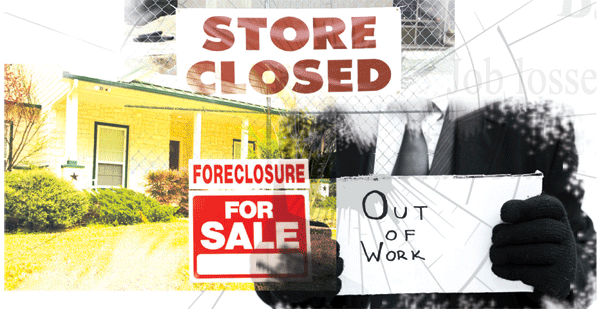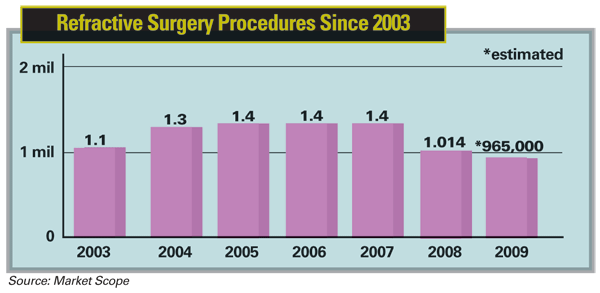Ignatius Hneleski III, MD, has seen refractive surgery procedures in his suburban
"I'm guessing that it's probably going to be at least another year and a half before it recovers," Dr. Hneleski says. "We're certainly keeping up our internal efforts with established patients, trying to generate interest in refractive surgery that way."
He has talked with marketing consultants about timing a step-up in external marketing when the market does recover. "I'm not sure when the time is to do that," he says.
When it comes to refractive surgery, Dr. Hneleski's guess is as good as anyone's. The precipitous drop in procedures in 2008, like the decline in the economy overall, caught a lot of people off guard. Now even the best forecasts don't see a recovery before the last quarter of 2009, and even then it won't be robust. "We're not looking for it to pick up materially until 2010," says Chris Cooley, a senior analyst at FTN Midwest Securities Corp. in
"It's a little bit like the canary in the coal mine," says Peter Bye, an analyst with Jefferies & Co. in

Not a Good Watershed
This could be a watershed year for refractive surgery. For the first time since 2002, the total volume of procedures in the
Like the stock market, the refractive surgery sector is taking a pounding. Total procedures were down 26 percent in 2008 from the year before, and some analysts see a further decline of 15 percent this year. The bottom fell out of the market in the second half of 2008, when procedure volume dropped up to 40 percent from the same period in 2007.
"LASIK fell about 25 percent last cycle and nearly 50 percent this cycle," Raymond James analyst John Ransom says of the third and fourth quarters last year. "Pretty brutal."
This circles back to the economy. The Conference Board Consumer Confidence Index declined to a new all-time low in December to 38. The Bureau of Labor Statistics reported the unemployment rate had risen to 6.7 percent in November, and some economists are projecting a double-digit rate before the economy recovers. "The continued downward pressure in the labor market will exert significant downward pressure on wages," says Gad Levanon, senior economist at the Conference Board.
None of this bodes well for a discretionary purchase that costs upwards of $2,000.
In this uncharted territory, Dr. Hneleski may not be off the mark by reining in his marketing. "We've never operated with a consumer confidence level at 38," Steven Rasche, CFO of TLC Vision Corp., told an earnings conference in November. "So we fully expected when we saw consumer confidence drop further in September and October [2008] that the marketing dollars were quite frankly not going to be as efficient as we'd like them to be."

Seven Strategies
How executives at major laser vision players and analysts are girding for the next year may shed some light on what a practitioner can do to not only nurture interest in refractive surgery until the economy recovers, but to cater to those patients who will pursue the procedure despite the economy.
1. Most candidates are still out there. An estimated 60 million people are considered candidates for refractive surgery. About 7.7 million have had the procedure so far. "So 91 percent of the opportunity still remains in front of us," says Steven Strauss, CEO of LCA Vision.
2. Contact lens wearers still want out. The population of contact lens wearers has been stuck around 36 million since 2005. "We know the dropout rate for contact lens wear is extremely high, that when a new person walks in another drops out," says Jim Mazzo, chairman and CEO of AMO. He says his company has set up programs to help ophthalmologists identify dissatisfied contact lens wearers.
Mr. Bye offers another tack to make LASIK appealing: "You could argue LASIK is still a cost savings if you get rid of your contacts for 12 years."
However, Dr. Hneleski in the past year has seen contact lens wearers postponing routine eye care. "People are putting that off, and that's part of the feeder system for refractive surgery," he says.
3. Follow the shifting demographic. The so-called baby boomers continue to comprise the bulk of refractive surgery patients, but their children are moving into that 21- to 60-year-old target audience. AMO has launched promotions on college campuses to extol the virtues of refractive surgery to Generation Y.
Mr. Mazzo has seen this approach work in
Not that baby boomers should be forgotten. "Our refractive cataract market, meaning people who pay cash to get their vision corrected after cataract surgery so they can see up close using advanced lenses, is actually continuing to increase," Dr. Hneleski says.
4. Understand what motivates people to investigate refractive surgery. AMO's research has identified three factors why the typical patient does not get LASIK: fear of the procedure, lack of awareness that he or she is a candidate and cost. The economy has amplified the impact of the latter, but that doesn't mean you should overlook the other two factors.
"We need to overcome the fear by letting people know that what they were told five years ago is not true today, that they can have the procedure," Mr. Mazzo says. "Price sometimes is a smokescreen for not overcoming the first two barriers."
That smokescreen may have lifted some since the FDA approved wavefront in 2003, and then advances such as the IntraLase, Advanced CustomVue and iFS Advanced Femtosecond technology followed. "I truly believe the fear factor for the most part is out of the procedure," Mr. Cooley says.
5. Price won't be an issue long term. The aggressive price cutting that typified refractive surgery in the early part of this decade won't be repeated in this economic slump.
Mr. Cooley has been intrigued by an arrangement LCA Vision has structured with health plans for a refractive surgery benefit that replicates the orthodontia benefits dental plans offer. "Although it's not a true indemnity plan, you do get a few dollars toward the procedure that represents a true material reduction in the price," he says. "Our impasse here is the economy and how much are you willing to pay? If we see those type of plans become more popular in the United States, I think it will be more evolutionary than revolutionary that could help foster more volume growth."
Further cuts in the procedure price would probably harm margins. "It's economically not worthwhile," Mr. Bye says.
For center operators, maintaining procedure price has been critical. TLC increased prices last year, and estimates its average revenue per procedure increased 4 percent to $1,748 in 2008 thanks to aggressive cost cutting in its operations. By the same token, marketing costs per procedure increased $38 despite the cuts.
6. Look inward. Evaluating your own processes can help your practice weather the cyclical downturn in refractive surgery. "Where can you, one, enhance the experience for the consumer in terms of providing education to help them get at ease with the procedure," says Mr. Cooley, "and, two, look at efficiencies in your own practice to help you strip out costs?"
A little diversification can go a long way. "We're glad we're not just laser vision correction," Dr. Hneleski says. "If we were a one-trick pony, that would be bad." Eye care and cataract surgeries are helping to carry his practice.
7. A rising tide floats all boats. As an observer of ophthalmic practices, Mr. Mazzo has seen too much competitive promotion to the detriment of the patients and practitioners.
"In
In Dr. Hneleski's practice, the phone calls and inquiries about LASIK continue to filter in. "It's more word of mouth and family members," he says of the source of those calls. He still talks about the procedure at chair side, but does not expect to see those efforts convert to procedures through this year. When they do, Dr. Hneleski aims to be ready for them.











